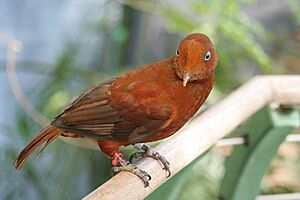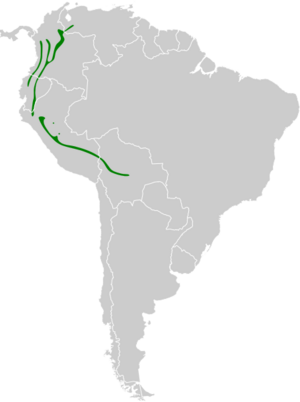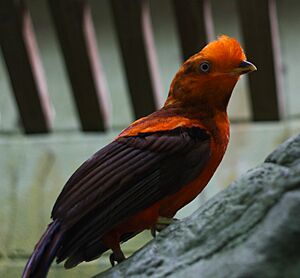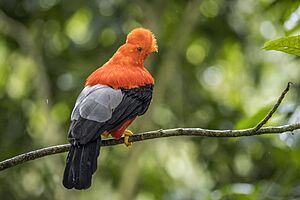Andean cock-of-the-rock facts for kids
Quick facts for kids Andean cock-of-the-rock |
|
|---|---|
 |
|
| Male R. p. sanguinolentus, Colombia | |
 |
|
| Female (nominate) | |
| Conservation status | |
| Scientific classification | |
| Genus: |
Rupicola (bird)
|
| Species: |
peruvianus
|
| Subspecies | |
|
|
 |
|
The Andean cock-of-the-rock (Rupicola peruvianus), also called tunki in the Quechua language, is a large bird found in the Andean cloud forests of South America. It belongs to the cotinga family. This amazing bird is the national bird of Peru.
Andean cocks-of-the-rock look very different depending on if they are male or female. Males are bright scarlet or orange with a big, disk-shaped crest on their head. Females are much duller, usually brown. Males gather together to show off their colorful feathers, bobbing and hopping to attract females. After mating, the female builds a nest and raises the young all by herself.
These birds mainly eat fruit, but they also snack on insects, small frogs, lizards, and even tiny mice. They live across a huge area of the Andes cloud forests, covering about 260,000 square kilometers (100,000 square miles). Even though their home is shrinking due to habitat loss, the Andean cock-of-the-rock is not currently considered an endangered species.
Contents
About the Andean Cock-of-the-Rock
What is the Andean Cock-of-the-Rock?
The Andean cock-of-the-rock is one of two species in its group, Rupicola. The other is the Guianan cock-of-the-rock. An English bird expert named John Latham first described this bird in 1790. It's part of the Cotingidae family, which are mostly fruit-eating birds living in tropical forests. The name Rupicola means "rock-dweller" in Latin, because these birds often build their nests on rock walls.
There are four different types, or subspecies, of the Andean cock-of-the-rock:
- R. p. peruvianus – This is the original type, found in Central Peru.
- R. p. aequatorialis – This type is the most common, found from Colombia to Peru.
- R. p. sanguinolentus – This type lives in western Colombia and northwestern Ecuador.
- R. p. saturatus – This type is found in southeastern Peru and western Bolivia.
How to Identify an Andean Cock-of-the-Rock?

The Andean cock-of-the-rock is a fairly large bird, about 32 centimeters (12.5 inches) long. It weighs around 265 grams (9.3 ounces), though males can be a bit heavier, up to 300 grams (10.5 ounces).
Males and females look very different, which is called sexual dimorphism.
- Males: They have a large, round crest on their head and bright scarlet or orange feathers. Their tail and wings are black, and they have pale grey feathers on their shoulders. Their beak is yellowish.
- Females: They are much duller and browner than the males. Their crest is also smaller. Their beak is dark with a small yellow tip.
The color of their eyes can change depending on the bird's gender and subspecies. Males can have red, orange, yellow, or bluish-white eyes. Females can have whitish, reddish, or brown eyes. When they are disturbed or flying, these birds make a loud, questioning "tank?" sound.
Where Do They Live?
Andean cocks-of-the-rock live in the cloud forests of the Andes mountains. Their home stretches across Venezuela, Colombia, Ecuador, Peru, and Bolivia. They prefer ravines and forested streams in mountainous areas, usually between 500 and 2,400 meters (1,600 to 7,900 feet) high. They usually stay in the lower and middle parts of the forest. They are quite shy and hard to spot. You might only see them briefly as they fly quickly through a valley.
Andean Cock-of-the-Rock Behavior
What Do They Eat?
Their main diet is fruit and insects. Sometimes, they also eat small lizards and frogs. They especially like fruits from certain plant families like Lauraceae and Rubiaceae. These birds are sometimes seen following army ants, eating the insects that the ants stir up.
How Do They Attract Mates?
Male cocks-of-the-rock are polygamous, meaning they mate with more than one female. Once they mate, the males do not help with nesting or raising the young. Instead, they spend their energy on amazing display rituals to show off their beautiful feathers.
These displays happen in special gathering places called leks. At a lek, males come together to challenge other males and attract females. It can be hard to watch them because they are easily disturbed. Their display activity depends on how much light there is, happening at similar light levels in the morning and afternoon.
At the lek, males often pair up and perform "confrontation displays." They face each other, bowing, jumping, and flapping their wings. They might even snap their beaks and make squawking and grunting sounds. When a female comes near, the display becomes even more intense. It turns into a loud mix of bright colors and frantic activity, filling the air with very strange sounds.
Breeding times vary by location. In Colombia, breeding usually happens from February to July. In Ecuador, it's from July to February.
How Do They Build Nests?
Only the female builds the nest. She uses mud mixed with plant material and her own saliva. She plasters the nest to cave entrances or rocky overhangs in forest ravines. The nest is shaped like a concave cup. The female typically lays two white eggs and sits on them for about 25 to 28 days until they hatch.
How Do They Help the Environment?
Andean cocks-of-the-rock help their environment in a few ways. For example, a white-capped dipper bird was once seen reusing an old cock-of-the-rock nest to lay its own eggs.
These birds also help spread seeds. When they eat fruit, the seeds pass through their digestive system and are dropped around their lek and nesting sites. This helps those seeds sprout and grow. Because of this, you often find more types of seeds growing near lek and nest sites compared to the rest of the forest.
Who Are Their Predators?
Andean cocks-of-the-rock face predators that are larger than those that hunt smaller songbirds. The bright displays of the males at the leks can attract attention. Animals that hunt adult cocks-of-the-rock include hawk-eagles, forest-falcons, hawks, owls, jaguars, mountain lions, ocelots, and the boa constrictor.
Andean Cock-of-the-Rock and Humans
The Andean cock-of-the-rock is a very special bird. It is the national bird of Peru. Sometimes, young or adult birds have been kept as pets.
Are They Endangered?
The total number of Andean cocks-of-the-rock in the world is not fully known, but experts believe they are not currently threatened. Even though their habitat is being destroyed, the species is listed as Least Concern on the IUCN Red List of Threatened Species. This means they are not in immediate danger. They are found in different areas, but their overall range is large enough to keep them safe for now.



